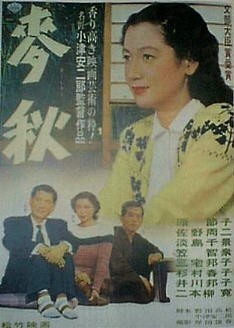- Early Summer
Infobox Film
name = Early Summer

caption =
director =Yasujiro Ozu
producer = Takeshi Yamamoto
writer =Kogo Noda
Yasujiro Ozu
starring =Setsuko Hara Chishu Ryu Chikage Awashima Kuniko Miyake
music = Senji Itō
cinematography = Yuuharu Atsuta
editing = Yoshiyasu Hamamura
distributor =Shochiku
released =October 3 ,1951
runtime = 125 min
country =Japan
language = Japanese
budget =
preceded_by =
followed_by =
amg_id = 1:15110
imdb_id = 0043313nihongo|"Early Summer"|麦秋|"Bakushū" is a 1951 film byYasujiro Ozu . Like most Ozu films, "Early Summer" deals with many issues ranging from communication problems between generations and the rising role of women in post-warJapan . The youngest generation is shown as spoiled brats, the middle generation is shown as one that either embraces or rejects change, and the oldest generation is shown as one that regrets change but realizes that it must happen.Noriko lives contentedly in an extended family household that includes her parents and her brother's family, but an uncle's visit prompts the family to find her a husband.
Cast
*
Setsuko Hara ... Noriko
*Chishu Ryu ... Koichi
*Chikage Awashima ... Aya Tamura
*Kuniko Miyake ... Fumiko
*Ichirô Sugai ... ShukichiDVD release
In 2004, the
Criterion Collection released with a new high-definition digital transfer, with restored image and sound and new English subtitle translation. Also included were the original theatrical trailer, an audio commentary byDonald Richie , "Ozu’s Films from Behind-the-Scenes", a conversation about Ozu and his working methods between child-actor and sound technician Kojiro Suematsu, assistant cameraman Takashi Kawamata, and Ozu producerShizuo Yamanouchi , and essays byDavid Bordwell andJim Jarmusch .Criticism
Film critic Dan Schneider wrote, of "Early Summer":
"..."There are few other rare breaks in the film from Ozu’s preferred cinematographic style- the ‘
tatami shot’, where the camera of cinematographer Yuuharu Atsuta is about three feet off the ground, and static, to remove special depth and allow the ‘action’ to often seem as if its occurring in two dimensional frames, like acomic strip . The framing within framing within framing device also suggests the great interior plunge that many of the scenes expose within their characters. Some critics have felt that this flattening out of the image is because Ozu wanted to explore exterior space, or form. While true, to a certain extent, Ozu’s films are far more searing and probing of the interior space of the characters than the exterior space of their world or homes. Yes, the material space is often a deep and multi-layered composition, dense with knick knacks, and suffused with Japanese geometric designs, but these would not have such significance were not the characters’ interior worlds also rigidly composed, and forced to change within the course of the films’ unfolding." [Dan Schneider. [http://unspokencinema.blogspot.com/2007/03/dvd-review-of-early-summer.html Unspoken Cinema] ]References
Further reading
* "Classic Japanese Screenplays: Ozu Yasujiro's Early Summer" translated by D.A. Rajakaruna. Simasahita Sankha Mudrana Silpiyo; (1997), ISBN 9559530003
* "Ozu Yasujiro's Two Post-War Films: Late Spring, Early Summer" translated by D.A. Rajakaruna. Godage International Publishers, (2006)External links
* [http://www.criterion.com/asp/release.asp?id=240&eid=369§ion=essay Criterion Collection essay by David Bordwell]
*
* [http://www.rottentomatoes.com/m/early_summer/ Reviews] atRotten Tomatoes .
* " [http://www.jmdb.ne.jp/1951/ca001640.htm Early Summer] " ja icon at theJapanese Movie Database
Wikimedia Foundation. 2010.
